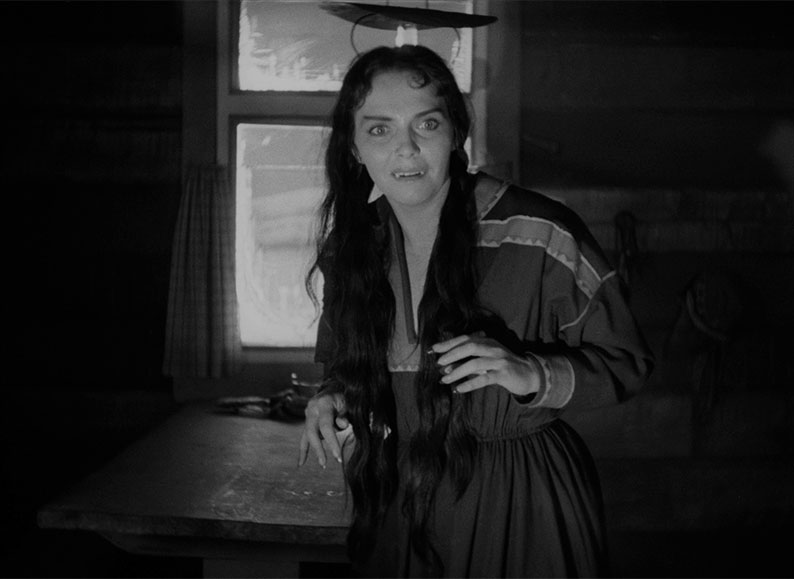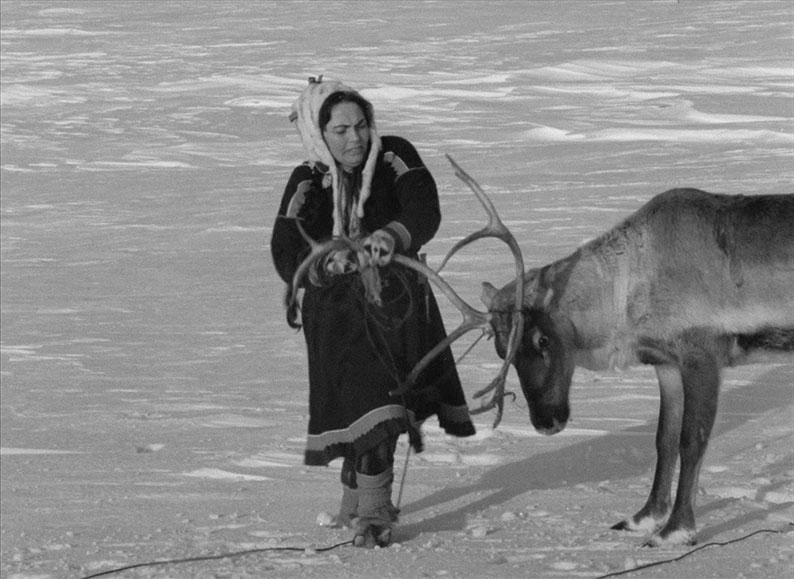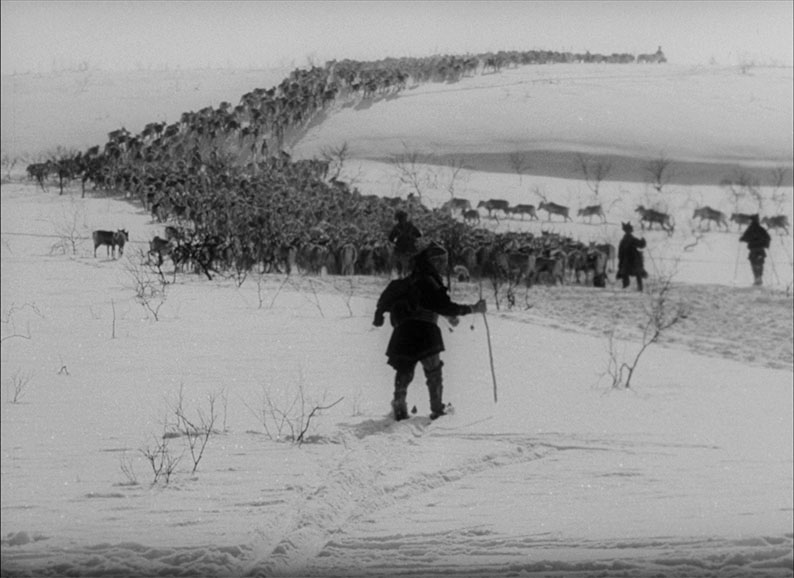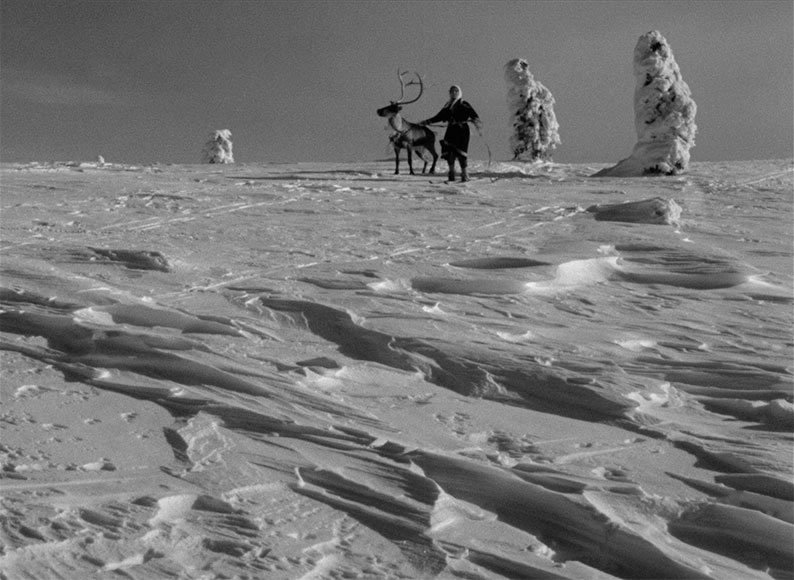|
The White Reindeer is a perfect example of how world cinema can introduce us to new cultures and new geographical locations – in this case the setting is Finnish Lapland. The traditional culture is called Sami and due to the remote and isolated northern environment the territory is rich with mythology and ripe for a supernatural folkloric tale, such as this film.
The central story concerns a witch named Pirita with supernatural abilities of transformation and immense seductive power over men. In the story her husband has the traditional role of a reindeer herder which keeps him away from home for weeks at a time. Against this backdrop the woman begins to explore her latent magical powers.

The White Reindeer is truly original and not easy to classify – it has been variously described as a horror folktale, a vampiric fairy tale and an art-house horror story. I am not at all interested in graphic exploitative horror films designed to shock or titillate the viewer, however I find this kind of treatment of horror themes to be absolutely enthralling. I would estimate that more than half of the film is essentially silent cinema – images and music without dialogue.
The film opens with a prologue that has a fever dream quality where a wordless song is accompanied by an ominous drum beat. The voice begins to narrate the story of a baby born in the snow who will discover later in life that she is a witch – this is paired with images of a woman (Pirita’s mother) and starkly beautiful landscape shots. This wordless song bookends the film giving the sense of a haunted tale being told.
The main character is Pirita and the success of this film rests on a brilliant performance by Mirjami Kuosmanen. She has a truly magnetic presence on screen and a powerful sense of physical energy and feminine beauty. Her theatrical gestures and facial expressions recall the great silent era performances.
Mirjami Kuosmanen was the wife of the director Erik Blomberg and as well as playing the lead role she co-wrote the story with him. The film was a real collaboration between this husband/wife team. True to the actress herself we see an athletic and vivacious woman who is unique amongst this Sami community - she is the only woman to compete in the all-male sleigh race. I was anxious watching the lead actress lasso a male reindeer, grab his horns and wrestle him to the ground - she looked like she grew up in the Sami community!

In 1952 the director had to use practical effects and I believe he made the right choice in never trying to depict the actual animal transformations – instead he uses key elements of expressionistic lighting. In the first transformation scene the lighting is used to darken Pirita’s face thus making her eyes and mouth disappear into dark shadows – really terrific!
The film marked the directorial debut of Erik Blomberg,who was already an accomplished cinematographer and documentarist and which is evident in the beautiful photography and the impressive performances from the non-professional cast. The director also edited the picture which gave him total control over the images in the film. There is an extraordinary sense of realism to the depictions of the Sami community and the herding scenes are truly authentic and add a magnificent visual background to the film.

The film explores classic feminist themes:
- The inability of men to accept responsibility for their own lust instead claiming that a woman has “put a spell on him” or has supernatural powers.
- The inability of men to accept women who sought liberation from restrictive patriarchal control.
- The woman who seeks to seduce men outside of her marriage. In this story the marriage seems to be a happy one and the husband appears to treat his wife with affection and respect.
- The “witch” accusation that usually resulted in the violent murder of the accused woman. Sami history includes this barbaric practice.
- The difficulty which arises by imposed domesticity on women particularly in this culture of animal herding.
Other themes include:
- The link between the moon and human behaviour – the full moon is the classic catalyst for an animalistic transformation.
- The idea of “selling one’s soul to the devil” in order to gain worldly power and the consequences that it ultimately brings. In this film the main character Pirita makes a pact with the “devil” and we watch her fate unfold. The white reindeer calf has a maternal link with Pirita and the sacrifice deepens the complexity of her Faustian pact.
The film packs so much into its short 68 minute running time – artistic photography, documentary realism, powerful performances, complex themes and an exciting supernatural tale. The fact that it was made on a very low budget is a testament to how talent is the primary ingredient in artistic success.
At the Cannes Festival in 1953 the film was awarded the Best International Fairy Tale Film - I did some research and this is the only film to have ever been given this award and so I presume that the Cannes jury felt that the film deserved a special prize. In 1956 it won the Golden Globe for Best Foreign Film.
The 2016 4k restoration by the National Audiovisual Institute of Finland is excellent and does full justice to the wonderful cinematography by Erik Blomberg. The print is very clean with excellent detail – look at the texture and shadows in the snowy landscape.

There are a handful of instances where noticeable flickering occurs due to print damage or where the image quality is less sharp. The aspect ratio is 1.37:1.
The film has a very interesting soundtrack by Einar Englung that helps to segment the film: the opening and closing music is ominous and sparse and creates the haunted tale atmosphere; the first section of the film has a festive type score that accompanies the joyful build up to the marriage; once Pirita approaches the Stone God Temple the score takes on a more driving momentum as the narrative picks up pace.
The LPCM 2.0 Mono Channel track audio sound was very good – dialogue is clear and apart from a few instances the musical score was in sharp focus.
There are optional English subtitles.
Audio Commentary by Kat Ellinger
This is an excellent commentary – Kat Ellinger has a style that is informal yet the content is very detailed and well structured. The topics that she covers in detail include Folk Horror, The Actress Marjami Kuosnamen, Sami History and Traditions, Gender Politics, The Director Erik Blomberg and The Release and Success of the Film.
With The Reindeer (7:49)
This is a terrific 1947 documentary by Erik Blomberg on the Sami tradition of reindeer herding. The most important resource in Sami culture is the reindeer – it provides milk, meat, skin hide and transportation (wonderful flat sleighs that the locals travel in). This short documentary serves to show just how authentic the Sami scenes in the film really are. The important herding and lassoing of the reindeer are essential skills that the locals learn from childhood.
Religion, Pleasure and Punishment: The Portrayal of Witches in Nordic Cinema (22:23)
This is a good piece that looks at the disturbing theme of the witch in Scandinavian Cinema from Haxan, Day of Wrath, Seventh Seal up to Anti-Christ.
Also present is Colour Test Footage (1:10) and 1952 Jussi Awards Ceremony feature – Finnish film awards (1:11), both of which are of interest but brief.
Collector’s Booklet
Informative essays by Alexandra Heller-Nicholas and Philip Kemp which are both informative and contain their own opinions on some of the themes in the film.
For me this release is what world cinema is all about – an insight into a culture and place that is totally unfamiliar to me. The central performance is utterly brilliant and the cinematography is spectacular in the depictions of the beautiful Finnish landscape and very effective in the chiaroscuro techniques that bring to life the emotional conflict within Pirita. The film has a sense of ambiguity which allows for multiple thematic interpretations and which will reward repeat viewings. If, like me, you are not a fan of the horror genre then do not let that put you off from exploring this wonderful work of art.
This is an excellent choice from the Masters of Cinema and the Blu-ray looks superb. A must-have in my opinion!
|